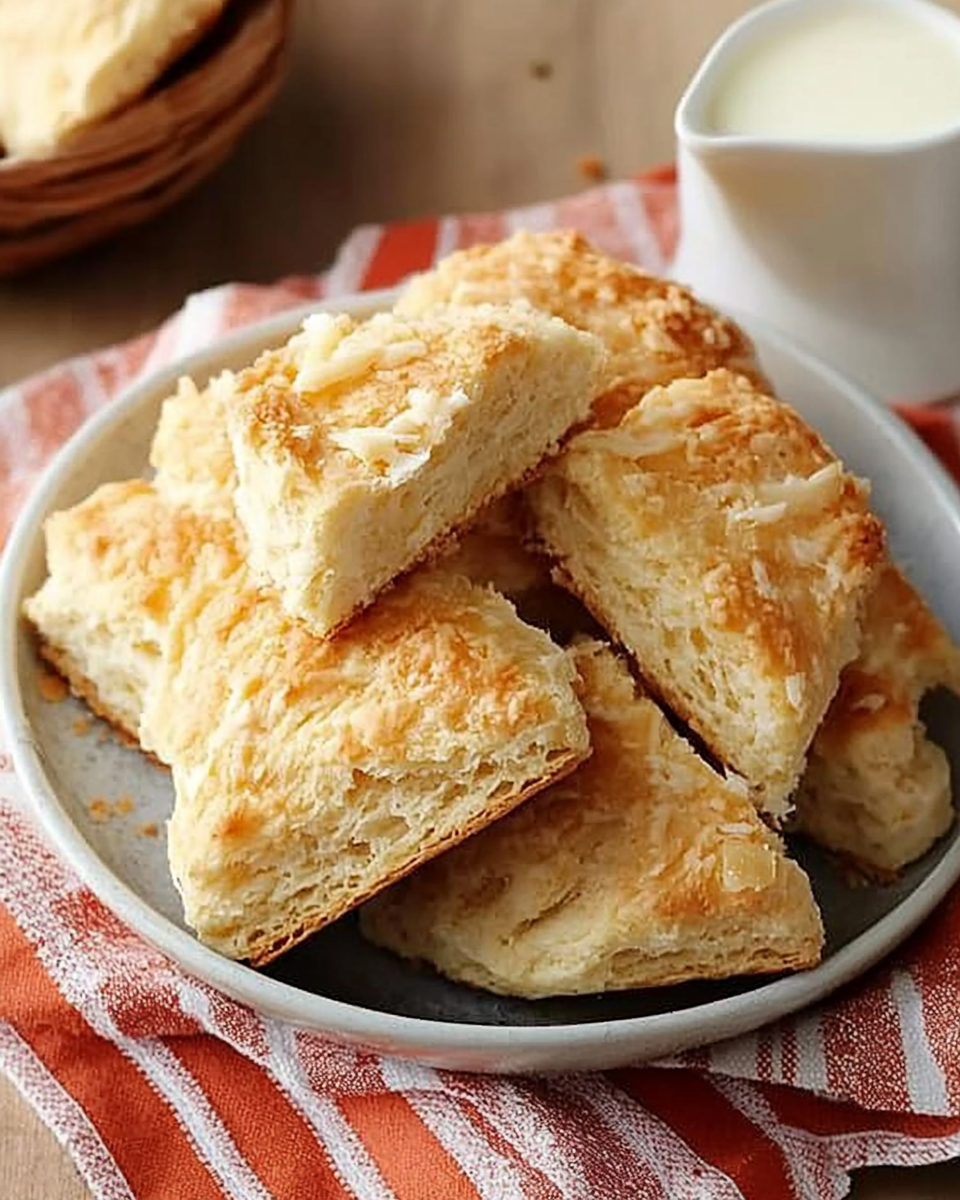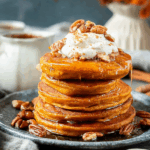These Parmesan Scones bring a perfect balance of buttery, flaky texture with the rich, nutty flavor of Parmesan cheese. Their golden crust cracks just right to reveal a soft, tender inside, making each bite utterly satisfying. Whether paired with a cup of tea or served alongside a fresh salad, these scones add a touch of warmth and comfort to any meal.
The beauty of this recipe lies in its simplicity and versatility. You can serve them plain, or jazz them up with herbs like chives or rosemary for extra aroma. Ideal for breakfast, brunch, or as a savory snack, these scones are quick to prepare and guaranteed to impress guests or satisfy your own cheesy cravings.
Full recipe:
Ingredients:
-
2 cups all-purpose flour
-
1 tablespoon baking powder
-
1/2 teaspoon salt
-
1/2 cup cold butter, cubed
-
1 cup shredded Parmesan cheese
-
3/4 cup milk
-
1 egg, beaten
Directions:
-
Preheat oven to 425°F (220°C).
-
In a large bowl, whisk together the flour, baking powder, and salt.
-
Cut in cold butter with a pastry blender or fork until mixture resembles coarse crumbs.
-
Stir in Parmesan cheese.
-
In a separate bowl, combine milk and beaten egg.
-
Gradually add the milk mixture to the dry ingredients, stirring until just combined. Do not overmix.
-
Turn dough onto a lightly floured surface and knead gently 8-10 times.
-
Pat dough into a 7-inch circle and cut into 8 wedges.
-
Place wedges on an ungreased baking sheet.
-
Bake 12-15 minutes or until golden brown. Serve warm.
Prep Time: 10 minutes | Cooking Time: 15 minutes | Total Time: 25 minutes
Kcal: Approximately 210 kcal per scone | Servings: 8 servings
The History and Popularity of Scones
Scones have a rich history originating from Scotland and England, where they were traditionally baked on griddles and enjoyed with clotted cream and jam. Over time, scones have evolved into many variations, including sweet fruit-studded versions and savory adaptations like cheese or herb scones. Parmesan scones belong to this savory branch, appealing to modern palates looking for a deliciously satisfying bite without the sweetness.
Their popularity has grown globally, partly because of their ease of preparation and the ability to customize with various cheeses, herbs, or spices. Parmesan, in particular, lends itself perfectly to scones because it melts slightly during baking, creating a wonderful texture and flavor contrast.
Why Parmesan Cheese is Ideal for Scones
Parmesan cheese is hard, aged, and full of umami, making it an ideal addition to savory baked goods. Its flavor is sharper and more complex than many other cheeses, which means you only need a small amount to impart a strong cheesy aroma and taste. Parmesan also adds a bit of crunch to the crust as it bakes, giving these scones a delightful textural element.
Moreover, Parmesan cheese contains natural salts, which means the overall seasoning of the scones is enhanced without having to add extra salt. The cheese also browns beautifully, contributing to the golden, appetizing crust that makes these scones so visually appealing.
Texture and Flavor Profile
The magic of Parmesan scones lies in their texture. The cold butter cut into the flour creates small pockets of fat that, when baked, produce a tender, flaky crumb. The high baking temperature encourages the scones to rise quickly, forming a crisp, golden exterior while maintaining a soft, moist interior.
Flavor-wise, these scones carry the savory depth of Parmesan, balanced by the slight sweetness from the milk and egg mixture. The buttery richness ties the whole flavor profile together, making every bite a savory delight that’s comforting and satisfying.
How to Serve Parmesan Scones
Parmesan scones are incredibly versatile when it comes to serving options. They are delightful on their own, fresh and warm from the oven, perfect for a quick snack or breakfast on the go. Their savory nature makes them excellent companions to soups and salads, adding texture and flavor without overpowering the main dish.
For a classic pairing, serve them with a spread of herb butter, garlic butter, or even a mild cheese spread to enhance their cheesiness. They also make a great side for brunch spreads featuring eggs, smoked salmon, or charcuterie. You can even use them as a base for small sandwiches, filled with ham, turkey, or fresh greens.
Tips for Perfect Parmesan Scones Every Time
Achieving the perfect Parmesan scones requires attention to a few key details. First, it’s essential to keep your butter cold and work quickly to incorporate it into the flour without melting. This cold butter is what creates the flaky texture that distinguishes a great scone from a dense biscuit.
Next, avoid overmixing the dough. Scones should be tender, not tough, so mix just until the ingredients come together. Patting the dough into a circle and cutting into wedges helps ensure even baking and a beautiful presentation.
Using freshly grated Parmesan cheese rather than pre-shredded is recommended for the best flavor and texture. Freshly grated cheese melts more evenly and has a stronger aroma.
Finally, bake the scones at a high temperature to develop a crisp, golden crust while keeping the inside light and fluffy.
Variations and Customizations
While Parmesan scones are delicious as-is, there are plenty of ways to customize them. Adding fresh or dried herbs like rosemary, thyme, or chives can introduce aromatic notes that pair wonderfully with Parmesan’s savory taste. For an extra kick, a pinch of black pepper or cayenne can add subtle heat.
You can also mix in other cheeses like sharp cheddar or asiago for different flavor profiles. Some people like to sprinkle a little extra Parmesan on top before baking for a beautifully caramelized crust.
For those seeking gluten-free options, experimenting with gluten-free flours that behave similarly to all-purpose flour can make this recipe accessible to more people without sacrificing texture or flavor.
Storing and Reheating Parmesan Scones
Parmesan scones are best enjoyed fresh, but if you have leftovers, they store well for a day or two at room temperature in an airtight container. To keep them fresh longer, you can freeze them before baking by wrapping the cut dough wedges tightly and baking from frozen, adding a few extra minutes to the bake time.
To reheat, pop the scones in a warm oven or toaster oven for a few minutes to regain their crisp exterior and warm interior. Avoid microwaving if possible, as it tends to make baked goods soggy.
Why Parmesan Scones Should Be Part of Your Baking Repertoire
Incorporating Parmesan scones into your baking routine offers a way to enjoy savory baked goods that are quick to prepare and delightfully tasty. They can be a reliable go-to when you need a savory snack or a side that complements many meals. Their ease, adaptability, and comforting flavor make them a crowd-pleaser at family breakfasts, casual get-togethers, or even as a charming addition to holiday spreads.
Their ingredients are commonly found in most kitchens, making this recipe accessible even on short notice. Plus, the ability to customize them means you can tailor the scones to suit your taste preferences or dietary needs without complicated substitutions.
Conclusion
Parmesan scones embody the perfect marriage of simplicity and flavor, creating a baked treat that is both comforting and elegant. Their crispy, golden crust paired with the tender, cheesy interior makes them an irresistible choice for anyone who loves savory baking. Whether enjoyed fresh from the oven, paired with your favorite spread, or served alongside a meal, these scones bring a touch of warmth and gourmet flair to everyday baking.
Easy to prepare and endlessly adaptable, Parmesan scones deserve a place in every baker’s repertoire. They remind us that sometimes the simplest recipes, made with quality ingredients and a little care, can become the most memorable and satisfying dishes on our table. So next time you want something savory and comforting, reach for Parmesan scones—they’re sure to please.






